
Alfred Stock was a German inorganic chemist. He did pioneering research on the hydrides of boron and silicon,coordination chemistry,mercury,and mercury poisoning. The German Chemical Society's Alfred-Stock Memorial Prize is named after him.
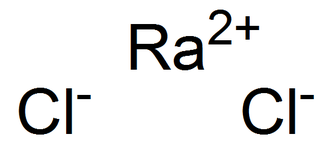
Radium chloride is an inorganic compound with the chemical formula RaCl2. It is a radium salt of hydrogen chloride. It was the first radium compound isolated in a pure state. Marie Curie and André-Louis Debierne used it in their original separation of radium from barium. The first preparation of radium metal was by the electrolysis of a solution of this salt using a mercury cathode.

The National Prize of the German Democratic Republic (East Germany) (German:Nationalpreis der Deutschen Demokratischen Republik) was an award of the German Democratic Republic (GDR) given out in three different classes for scientific,artistic,and other meritorious achievement. With scientific achievements,it was often given to entire research groups rather than individual scientists.
Antimony pentasulfide is an inorganic compound of antimony and sulfur,also known as antimony red. It is a nonstoichiometric compound with a variable composition. Its structure is unknown. Commercial samples are contaminated with sulfur,which may be removed by washing with carbon disulfide in a Soxhlet extractor.
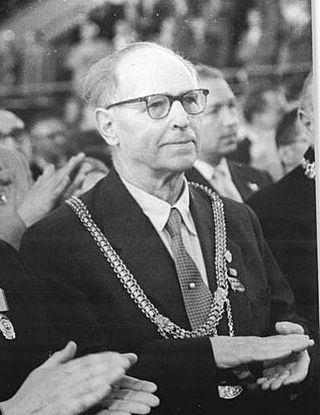
Max Volmer was a German physical chemist,who made important contributions in electrochemistry,in particular on electrode kinetics. He co-developed the Butler–Volmer equation. Volmer held the chair and directorship of the Physical Chemistry and Electrochemistry Institute of the Technische Hochschule Berlin,in Berlin-Charlottenburg. After World War II,he went to the Soviet Union,where he headed a design bureau for the production of heavy water. Upon his return to East Germany ten years later,he became a professor at the Humboldt University of Berlin and was president of the East German Academy of Sciences.
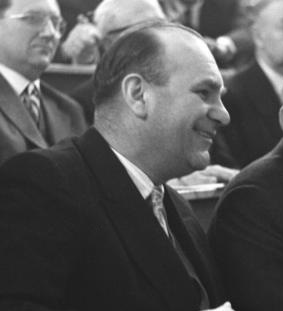
Heinz Barwich was a German nuclear physicist. He was deputy director of the Siemens Research Laboratory II in Berlin. At the close of World War II,he followed the decision of Gustav Hertz,to go to the Soviet Union for ten years to work on the Soviet atomic bomb project,for which he received the Stalin Prize. He was director of the Zentralinstitut für Kernforschung at Rossendorf near Dresden. For a few years he was director of the Joint Institute for Nuclear Research in Dubna,Soviet Union. In 1964 he defected to the West.

Polonium hydride (also known as polonium dihydride,hydrogen polonide,or polane) is a chemical compound with the formula PoH2. It is a liquid at room temperature,the second hydrogen chalcogenide with this property after water. It is very unstable chemically and tends to decompose into elemental polonium and hydrogen. It is a volatile and very labile compound,from which many polonides can be derived. Additionally,it is radioactive.

Vanadium(V) fluoride is the inorganic compound with the chemical formula VF5. It is a colorless volatile liquid that freezes near room temperature. It is a highly reactive compound,as indicated by its ability to fluorinate organic substances.
Rolf Landsberg was a German Professor of Physical Chemistry.
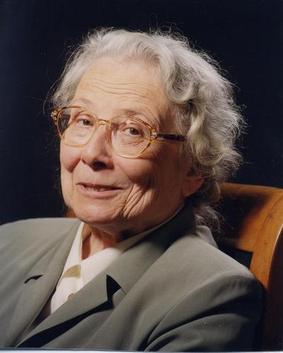
Margot Becke-Goehring was a Professor of Inorganic Chemistry at the University of Heidelberg and she was the first female rector of a university in West Germany - the Heidelberg University. She was also the director of the Gmelin Institute of Inorganic Chemistry of the Max Planck Society that edited the Gmelins Handbuch der anorganischen Chemie. She studied Chemistry in Halle (Saale) and Munich,and she finished her doctorate and habilitation at the University of Halle. For her research on the chemistry of main-group elements,she was awarded Alfred Stock Memorial Prize. One of her most notable contributions to inorganic chemistry was her work on the synthesis and structure of poly(sulfur nitride),which was later discovered to be the first non-metallic superconductor. For her success in editing the Gmelins Handbuch der anorganischen Chemie,she received the Gmelin-Beilstein memorial coin.
Alexander Classen was a German chemist,who is considered one of the founders of electrochemical analysis.
Wilhelm Karl Klemm was an inorganic and physical chemist. Klemm did extensive work on intermetallic compounds,rare earth metals,transition elements and compounds involving oxygen and fluorine. He and Heinrich Bommer were the first to isolate elemental erbium (1934) and ytterbium (1936). Klemm refined Eduard Zintl's ideas about the structure of intermetallic compounds and their connections to develop the Zintl-Klemm concept.
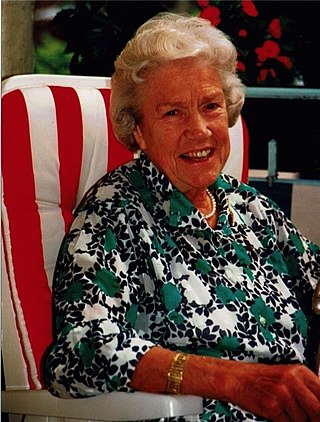
Brigitte Sarry was a German chemist and a professor at Technische Universität Berlin.

Hermann Klare was a chemistry academic who played a prominent role in scientific administration and research in the German Democratic Republic (GDR). Klare held professorships at the Technical University Leuna-Merseburg and at Humboldt University (Berlin). From 1968 to 1979 he was president of the German Academy of Sciences.

Thiothionyl fluoride is a chemical compound of fluorine and sulfur,with the chemical formula S=SF2. It is an isomer of disulfur difluoride (difluorodisulfane) F−S−S−F.
Walter Rüdorff was a German chemist known for his research on clathrates of graphite and ternary oxides.

Gunnar Hägg was a Swedish chemist and crystallographer.

The hexafluoroarsenate anion is a chemical species with formula AsF−6. Hexafluoroarsenate is relatively inert,being the conjugate base of the notional superacid hexafluoroarsenic acid.
Protactinium(V) bromide is an inorganic compound. It is a halide of protactinium,consisting of protactinium and bromine. It is radioactive and has a chemical formula of PaBr5,which is a red crystal of the monoclinic crystal system.

Holmium(III) iodide is an iodide of holmium,with the chemical formula of HoI3. It is used as a component of metal halide lamps.















